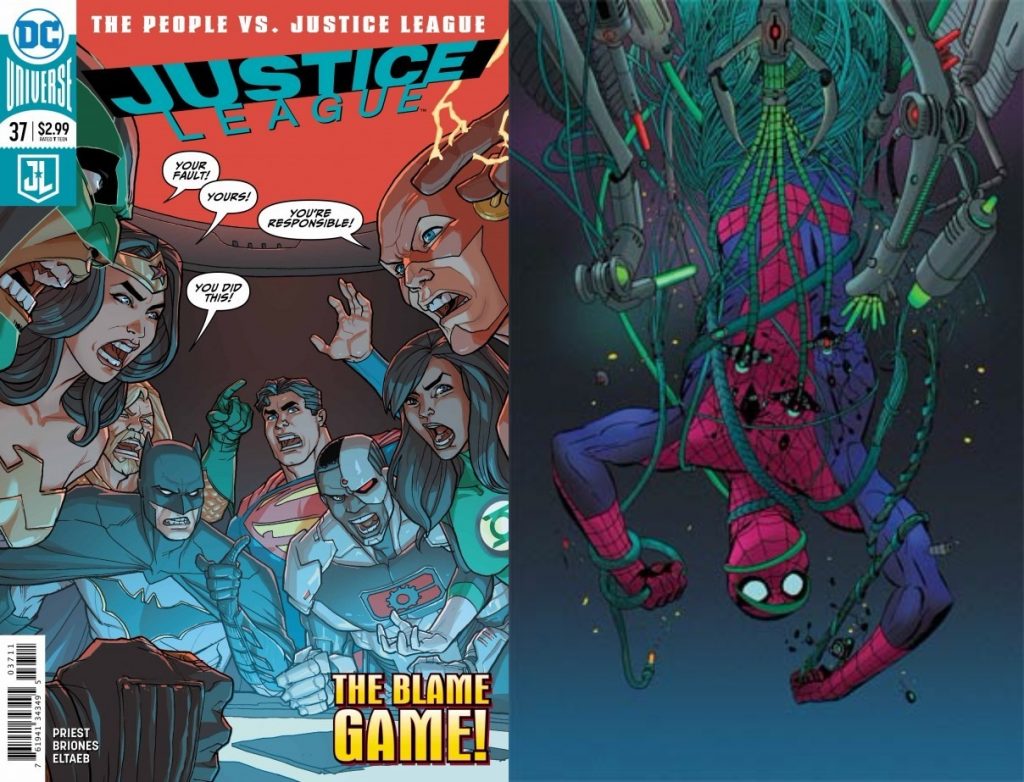
David Uzumeri is reading…
Peter Parker: The Spectacular Spider-Man #299
Written by Chip Zdarsky
Art by Adam Kubert and Juan Frigeri
Colored by Jason Keith
Lettered by Travis Lanham
Marvel Comics
“Harrumph! I’ve seen bigger, cleaner journalist apartments!”
When Chip Zdarsky was announced as writing a new Howard the Duck series at Marvel a couple years ago, it felt like a natural fit in terms of sense of humor. But Zdarsky’s writing career prior to his time as an editorial cartoonist at stalwart Canadian moderate-conservative paper The National Post (no, fucking really) didn’t give much indication as to how he’d run with longform narratives combining comedy and drama to create pathos. By the seventh issue, I was literally in tears at the sad and uplifting tale of Howard the Duck and Rocket Raccoon’s female clones, and by the end he’d provided a cohesive, affecting, and above all very funny arc. But it was weird and off-beat and, despite being a very Marvel Universe book, it didn’t feel like it was in the Marvel style.
After a short pit-stop on Star-Lord with Kris Anka (an underrated book), Marvel threw him with Adam Kubert—one of the most celebrated and Marvel-ass artists in Marvel’s stable—on a new Spider-Man #1 to accompany last year’s box-office-smashing reboot film that placed the character in the Marvel Cinematic Universe. It was the largest spotlight yet placed on Zdarsky’s writing, and it’s on the character who almost defined meat-and-potatoes superhero drama. How’d he do with longform storytelling on the prototypical superhero soap opera?
Well after this long-ass preamble it’d be pretty pointless for the answer to be “he sucks at it,” so yeah, of course this book is really good. It hit an early high with #6, the emotional issue where Spider-Man reveals his real identity to J. Jonah Jameson, and since then it’s been putting the pieces together that finally coalesce in the final moments of this issue, leading into the upcoming anniversary #300, and he’s done it old school — interesting new supporting cast members, mining continuity for new ideas and rearranging them in fascinating ways, and working with Adam Kubert (and various fill-in artists) to create dynamic, interestingly laid-out action sequences. Spider-Man’s maybe-sister Theresa (from the Family Business graphic novel) and the Tinkerer’s heretofore-unheard-of morally upright brother are great new injections into the formula, and I’m excited to see everything come together next issue and where the series goes from here, especially as Dan Slott prepares to leave the character’s flagship title.
David Uzumeri is also reading…
Justice League #37
Written by Priest
Art by Philippe Briones
Colored by Gabe Eltaeb
Lettered by Willie Schu
DC Comics
“Why are you following people you should be leading?”
Priest’s Justice League run pitting the Justice League against the court of public opinion continues apace as the plans of a batshit insane fan who’s trying to “improve” the Justice League by un-tethering them from human oversight comes to fruition. It’s typically savvy and byzantine, because it’s a villain in a Priest comic and everything requires a flowchart, but it’s also the first time since Priest’s return that I’ve really felt his time off from comics has hurt the quality of his work. Not because he’s behind the times, but because he missed a lot of comics, and there are ideas here that are introduced as novelties that formed the core of books like Civil War and Identity Crisis.
Stories of superhero teams struggling with civilian oversight are nothing new, but the specific circumstances of this crisis — a televised fuck-up leading to a public outcry—are especially familiar, although the idea of having Batman be the one to cock up a situation is quite novel. New artist Philippe Briones does a great job on this issue, too—it’s not the revelation that Pete Woods reinventing himself as penciller-inker-colorist for the last three issues was, but it’s attractively rendered art with solid storytelling and character acting, all pretty essential elements for translating a Priest script.
(SPOILERS FROM HERE)
The end of the issue, though, is what really makes me wonder the endgame here. The very first title card of the issue is “Identity Crisis,” and this issue’s finale — the Fan placing himself into a situation of being caught and knowing the Justice League’s identities and secrets, so they have to figure out what to do with him once he’s captured—is literally the conundrum that led to the mindwiping mechanism that drove, like, two fucking years of DC superhero comics in the mid-‘00s. And with Priest’s time away from writing for the medium in that time—and, I imagine, reading it — I’m not sure if what’s coming is a riff on that established concept or a reinvestigation.
(END SPOILERS)
Priest is one of the smartest and most empathetic guys to ever type “PAGE ONE PANEL ONE,” though, so I know I’m going to enjoy the end result either way. It’s smart, timely, consistent superhero comics every two weeks in Justice League, coming from the one writer I would have bet a few years ago would never come back to the game (and certainly not with this much fanfare and publisher support), and I’m here for $2.99 until his name’s off the cover.

